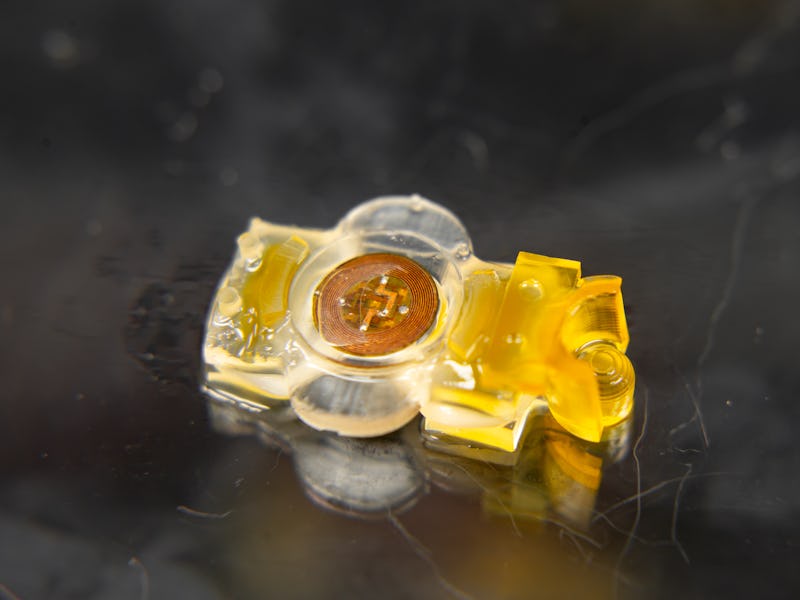This biohybrid robot walks using lab-grown mouse muscles
Engineers have created the fastest-moving part-meat robot yet.

Czech playwright Karel Capek coined the word “robot” in his seminal 1920 work, “Rossum’s Universal Robots.” In this dark piece of sci-fi, the term described flesh-and-blood laborers made from organic matter and forced to perform menial factory work.
Today, “robot” is largely used to describe an entirely different type of worker — an automaton usually made from steel and plastic. But that connotation may soon begin to swing back towards Capek’s organic vision.
A team of researchers came up with a new design for remote-controlled walking robots that run on lab-grown muscle tissue and light, according to a recent paper published in Science Robotics. Their unique biohybrid even bot set a new speed record for this kind of part-machine, part-meat system.
A time-lapse image of a new biobot “walking” through barriers.
“We had to really redesign and rethink our structure so that the different components could work well together,” Mattia Gazzola, a mechanical engineer at the University of Illinois Urbana-Champaign and study co-author, tells Inverse.
In fact, he and his team created one of the most robust biohybrid bot proofs-of-concept to date. This field is still a brave new world — and Gazzola’s research marks just one step toward an organic cyborg future.
Here’s the background — Biohybrid robots are a fusion of artificial and living parts, a sci-fi concept brought to life. The term encompasses everything from cyborg insects to tiny remote-controlled microorganisms and mechanical vehicles powered by muscle tissues.
The field is pretty young — most major biorobotics breakthroughs arrived in the last decade or so. “The main disadvantage at the moment is that as a technology, it’s not as mature as its artificial counterparts,” Gazzola says. That means that biohybrid robots might be slower or less durable compared to more traditional machines.
A bipedal bot that doesn’t require batteries or wires.
What’s new — The new biohybrid robots combine three major components: mouse muscle cells, soft 3D-printed structures called scaffolds, and wireless LED control chips. The LED chips use light to stimulate the mouse tissue. As the muscles contract, they contort the scaffold which, thanks to its asymmetrical design, spurs the robot to “walk” forward.
Using this approach, the robots reached speeds of up to .83 millimeters per second — not exactly NASCAR material, but still the fastest speed ever achieved by this type of biohybrid.
The design also frees the robot from wires or clunky batteries, so it’s more mobile than its predecessors. “You can basically beam energy into the chip,” says Gazzola, “so that means that you don’t need power onboard.”
The team even designed a series of swappable LEGO-inspired robot attachments for a variety of tasks. Using these tools, the bots could collect a series of small objects or plow through them with ease. The researchers designed both monopedal and bipedal versions of the devices that were capable of maneuvering through a maze.
Bio-based robots can sense or react to certain stimuli without having to be programmed.
Why it matters — Bio-based robots like Gazzola’s have some distinct advantages over fully artificial ones. For example, the living cells they employ can naturally sense or react to certain stimuli, such as light, heat, or various chemicals, without having to be programmed. “It’s not a trivial thing to make an equivalent artificial counterpart,” Gazzola says. Some biohybrid bots also have the power to heal themselves — or even reproduce.
Taken together, these qualities make biohybrids an exciting area of research for roboticists and bioengineers alike.
What’s next — This new research provides plenty of jumping-off points for future studies, Gazzola says. Some scientists may want to work on developing faster biohybrid robots, while others may want to fine-tune the wireless control system and extend its range.
Gazzola aims to grow and integrate neural cells into the system, enabling the bots to make rudimentary computations on their own and potentially steer themselves.
While the future of biohybrid robots is still wide open, we’re inching closer toward it — one light-induced muscle contraction at a time.
This article was originally published on